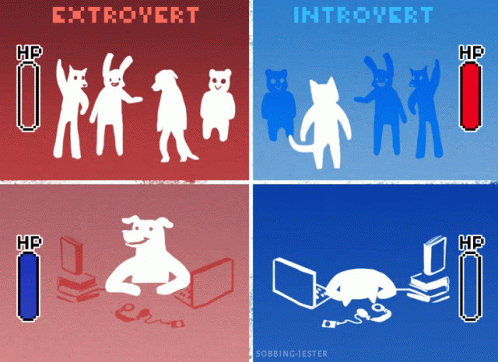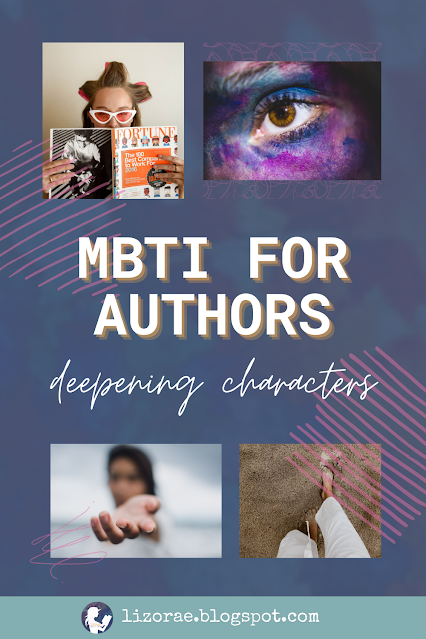MBTI For Authors: 16 Personality Types To Deepen Characters
The Myers-Briggs Type Indicator, or MBTI for short, is currently one of the most well known personality tests in the world. Whether you think it's accurate or not, it's undeniably an incredible tool for crafting characters.
Sentinels (SJ):
MBTI is an incredibly useful tool when you're trying to figure out who your characters are. It'll help us understand how they think and interact in their environment. You can figure out what type your character is using either the letters or the functions. However you do it, figure out their functions so you can mess around with loops and grips as story piles up their trauma. It will also help you figure out character dynamics in whatever relationship they're in, whether romantic, rivals, romantic rivals, and so on!
Comment + Share + Follow
What is MBTI, exactly? It uses 16 base personalities given in a four letter code. This code unlocks a character's personality, giving their strengths and weaknesses. But the real core of MBTI is to illustrate how a character thinks and interacts with their world.
A character's MBTI can be used to give a general idea of all sorts of things. Their kind of humour, what type of job they'd choose, who they get along with and who they're worst enemies with. It gives an idea of what a character would value and how they would react to things.
But MBTI does not a character make. It's simply a tool, the same way the three act structure by itself a plot. It also isn't one size fits all. There's so many factors that go into who a character is. For instance, their cultural background or traumatic experiences will affect the character's functions. We'll get into that more next week.
For now, here's an in depth look at how authors can use MBTI to write nuanced characters.
1. The 16 personalities
The 16 types are most commonly divided into four groups, or temperaments. 16personalities.com call these temperaments the analysts, diplomats, sentinels and explorers. Along with the list, I'll also add the meaning of the four letter code and the function stack, all of which will be explained in this post! The types are:Analysts (NT):
- INTJ: Introverted intuition thinking judging, Ni Te Fi Se
- INTP: Introverted intuition thinking perceiving, Ti Ne Si Fe
- ENTJ: Extroverted intuition thinking judging, Te Ni Se Fi
- ENTP: Extroverted intuition thinking perceiving, Ne Ti Fe Si
Diplomats (NF):
- INFJ: Introverted intuition feeling judging, Ni Fe Ti Se
- INFP: Introverted intuition feeling perceiving, Fi Ne Si Te
- ENFJ: Extroverted intuition feeling judging, Fe Ni Se Ti
- ENFP: Extroverted intuition feeling perceiving, Ne Fi Te Si
Sentinels (SJ):
- ISTJ: Introverted sensing thinking judging, Si Te Fi Ne
- ISFJ: Introverted sensing feeling judging, Si Fe Ti Ne
- ESTJ: Extroverted sensing thinking judging, Te Si Ne Fi
- ESFJ: Extroverted sensing feeling judging, Fe Si Ne Ti
Explorers (SP):
- ISTP: Introverted sensing thinking perceiving, Ti Se Ni Fe
- ISFP: Introverted sensing feeling perceiving, Fi Se Ni Te
- ESTP: Extroverted sensing thinking perceiving, Se Ti Fe Ni
- ESFP: Extroverted sensing feeling perceiving, Se Fi Te Ni
2. Unpacking the four letter code
The four letter code comes from eight possible letters. These eight letters are paired, so there's only 16 possible outcomes, for those who are mathematically inclined. You weirdos. (Lol, just kidding!) The pairs represent a certain aspect of a character's personality.The first letter: Introversion or Extroversion. This indicates where someone gains energy from. An introvert is energised by spending time in their internal world. They love their solitude and need time to rest and recharge before heading into the big wide world of people. An extrovert is energised by spending time in their external world. They love their social gatherings and recharge by hanging around people.
 |
| Source: Tenor |
It's important to note that introversion and extroversion is a scale. Some introverts will always hate going out, but some may need social interaction after they've recharged. Some extroverts will always hate staying in, but some may need alone time to rest. This is where ambiversion comes in, but characters will almost always have even a slight preference for one or the other. Hence, introvert or extrovert.
The second letter: Intuition or Sensing. This is how someone sees the world. Everyone uses both, but people are stronger in one or the other. Characters with a preference for intuition like exploring theories and abstract concepts, living in the future and figuring out possibilities. Characters with a preference for sensing live in the moment, using their five senses and physical sensations to solve problems practically.
The third letter: Thinking or Feeling. This is the basis of how people make decisions. Like with intuition and sensing, everyone has both, but people have a preference for one or the other. Thinking based characters are persuaded by facts and logic. Personal feelings and conflicts don't matter compared to the cold hard facts. Feeling based characters are persuaded by values and emotions. They dislike conflict, internal or external.
The fourth letter: Judging or Perceiving. This refers to how people like to make decisions. Judgers like having plans and finalising decisions for closure. They have a hard time being spontaneous or dealing with surprises. Perceivers like to leave possibilities open and explore all the choices, thriving in spontaneity and surprises. They have a hard time following schedules and making decisions quickly.
Case studies:
- INTJ = introverted, intuition, thinking and judging. The INTJ will prefer alone time over socialising, like theorising the future, make decisions based on logic and be organised.
- ESFP = extroverted, sensing, feeling and perceiving. The ESFP will prefer socialising over alone time, like living in the moment, making decisions based on emotions and being spontaneous.
The letters exist to give a general understanding of the personality type at a glance. It will give the overall type of vibe a character will have. Things like how often they go out, what they enjoy doing and how organised they are.
For some characters, understanding this is enough. But for your major characters, or if you want to create more memorable characters, you'll want to go deeper.
3. What the code means: cognitive functions
The letters give a rough idea of what a character is like, but what they really stand for is a character's cognitive functions. This is where it gets more complicated. There are eight functions in total, but it's easier to think of them as four pairs. The pairs have the same first letter in shorthand, as you'll see in one paragraph.
There are four perceiving functions and four judging functions. The perceiving functions are how a person gathers information from their environment. These are:
- Introverted intuition, Ni: memorises interpretations and patterns, which can be used to predict the outcome of current events. They look for the deeper meaning and core message of things. Think visionaries or strategists and trend predictors for highly stereotypical connotations (etc for examples in this list).
- Extroverted intuition, Ne: sees possibilities and what could be. They are good at coming up with ideas and finding seemingly random connections between them. Think random word generators and the wacky scientist.
- Introverted sensing, Si: is strong to their experiences and how it made them feel. Si-users memorise these subjective experiences, creating a massive catalogue they can compare and contrast the present to. Think traditionalists and uptight policemen.
- Extroverted sensing, Se: is strong in interacting with their physical environment. They like the stimulus of the present environment and can react quickly to changes. Think athletes and femme fatales.
 |
| Source: Very Well Mind |
Judging functions are how a person makes decisions using the information gathered via their perceiving functions. These are:
- Introverted feeling, Fi: makes decisions based on their own values and idea of what's right and wrong. They want to act according to what will bring harmony to their feelings. Think the individualist and songwriter.
- Extroverted feeling, Fe: makes decisions based on what's best for everyone and what will keep the harmony. They tend to be good at empathising and focus on external personal systems. Think charismatic leader and counsellor.
- Introverted thinking, Ti: figures out how something works and develops an individualistic framework from their understanding of how the world works. They make decisions by knowing what makes sense. Think scientists.
- Extroverted thinking, Te: wants to figure out what works and what will get the best results. They make decisions based on objective facts and standards, organising the world using their systems. Think the strict boss and CEO.
The functions are stacked in order from a character's strongest to weakest, which develop over time. Each stack has two perceiving and judging functions alternating.
The strongest function, the dominant function, is the one that develops most; the one the character will depend on. The second strongest function, the auxiliary function, aids the dominant function and guides how the character uses it. The last two functions, the tertiary function and the inferior function, are less developed than the first two, so are weaker, but they provide what the first two functions don't.
Case studies:
- INTJ = Ni Te Fi Se. The INTJ will look for patterns in objective facts and standards. With character growth, they will also consider how their values affect others and be able to live more in the present.
- ESFP = Se Fi Te Ni. The ESFP lives for physical stimuli and acts according to their values. With character growth, they will learn the rules and patterns of society.
Notice how opposite letters don't necessarily mean opposite cognitive functions? We'll get more into that in the next part.
4. Typing your characters
Now for the fun part! How should we type characters? Often, you'll have a general idea of their personality already. You might find it easier to simply take some personality quizzes online and go from there. But let's assume you have a blank slate or want to go deeper. Or maybe you're just a try-hard like me.
When typing characters, you'll generally want to figure out their cognitive function preferences over the letters because the functions show how a character thinks, the letters are just the code. Consider the examples from Part 3. The INTJ and ESFP are opposite in letters, but are really the same functions backwards. While an INTJ and ESFP will rely on different functions, they have enough common ground to balance out their differences. Clashes in functions generally provide more conflict than different letters while shared functions mean shared mental processes.
With a new cast, consider character dynamics. Do you want rivals who don't think on the same page? Or do you want characters to be two peas in a pod? Perhaps something in the middle where the characters, love interests perhaps, complement each other?
 |
| Source: Gfycat |
For maximum personality conflict, consider the polar opposite. A polar opposite would be a double swap: swapping the order of the functions and switching the function into its pair. For example, an INTJ's (Ni Te Fi Se) polar opposite would be the ISFJ (Si Fe Ti Ne). While an INTJ will rely on using subjective patterns and interpretations in objective frameworks, the ISFJ will rely on subjective experiences and how it relates to the personal external environment. The future oriented, logic based inclination of the INTJ will grate against the ISFJ's traditionalist and emotion based views.
Conversely, you might want certain characters to be similar. This generally means that the characters will either share a dominant and inferior function or one character's dominant function is the other's auxiliary function. For instance, the INTJ's dominant function is Ni (introverted intuition) and inferior function is Se (extroverted sensing). There will only be one other type that shares this dominant and inferior function, and in this case, it's the INFJ. Both will use Ni to form subjective interpretations from experience but while the INTJ applies it to objective impersonal standards, the INFJ will apply it to objective personal standards. The two types that use Ni as their auxiliary function are the ENTJ and ENFJ, who don't rely on it, but use it to support their views on objective impersonal standards and objective personal standards respectively. For obvious reasons, characters sharing a dominant function will have more in common than characters with the dominant/auxiliary difference.
 |
| Source: Tenor |
Complementary characters have the inverted function pair in their dominant and inferior functions (eg: Ni to Ne, Fe to Fi, etc.). As only two types will share dominant functions, you have two types to pick from. The one that is generally most complementary will be the one that also shares their auxiliary and tertiary functions, if in a different order. Back to the INTJ (Ni Te Fi Se) example, their complementary type is the ENFP (Ne Fi Te Si). The INTJ will find patterns in the possibilities the ENFP will imagine. The INTJ and ENFP can learn to develop their auxiliary and tertiary functions from each other. The other option is the ENTP (Ne Ti Fe Si). The INTJ and ENTP will also bounce off each other with the Ni/Ne dynamic, but they rely on different decision making functions so they may not always see eye to eye. (Hint: The shortcut way to figure out a character's complementary type is to swap the four letter code to its opposite, keeping the second letter (N/S) the same. eg: INFJ to ENTP, ISTJ to ESFP)
An important thing to remember is that type does not a relationship make. Just because characters rely on different functions doesn't mean that they'll automatically be rivals. Opposites attract. Just because characters rely on the same functions doesn't mean that they'll automatically be friends. Like charges repel. While type does play in how characters interact with each other, it does not define how bonds are made. Healthy communication will improve a relationship no matter the characters' type and unhealthy communication will destroy.
5. The nuances of personality
MBTI is essentially a framework used to quickly shape a character. It helps us understand how our characters think. But like with all things, experience will weather them. That's how characters change. And with change, characters will probably alter thought patterns. We're sadists authors after all. We love the drama.
Before we start, your type isn't definitive during childhood and even adolescents. This is because that time is taken for the functions to develop. Because life, people will start using certain functions over others, until the functions are developed or underdeveloped enough that they form a rank. Hence the dominant, auxiliary, tertiary and inferior stuff. That said, type doesn't change. You can develop your weaker functions so they're stronger, but that can take a lifetime. But there are times when it may seem like personality has changed. So let's talk about loops and grips.
No, not the swirly whirly or the grippy grippy ones. In times of stress, characters will be trapped into a loop. This is when the character goes round and round between their dominant and tertiary function, bypassing the auxiliary. Without the auxiliary and inferior function to back up their normal mental processes, things can go haywire. For example, the INTJ (Ni Te Fi Se) will be stuck in a Ni-Fi loop: the negative "I suck" feelings from Fi and the "others figured this out, why can't you?" confirmation by comparison from Ni. Te and Se are repressed, resulting in an unproductive mental state.
In times of extreme stress, characters will fall into a grip. This is when the character's mental processes are driven by their inferior function instead of their dominant. They rely on their weakest function; the one that may not develop until way into adulthood. Again to our INTJ example, the INTJ falls into a Se-grip, becoming impulsive and indulgent. It seems like their personality has completely changed as they act like an unhealthy ESFP, their letter opposite.
One question that I haven't answered yet is how functions are developed. Since this post is already long and late (lol), I'll get to that in my next post on finding your characters. Stay tuned and subscribe so you don't miss it!
~
Authors, let me know in the comments below: how do you use MBTI to form your characters? What do you find the hardest / easiest aspect to understand? Which characters are your favourite or least favourite to type? Do you find it helpful?
Until next time, happy authoring!


Comments
Post a Comment